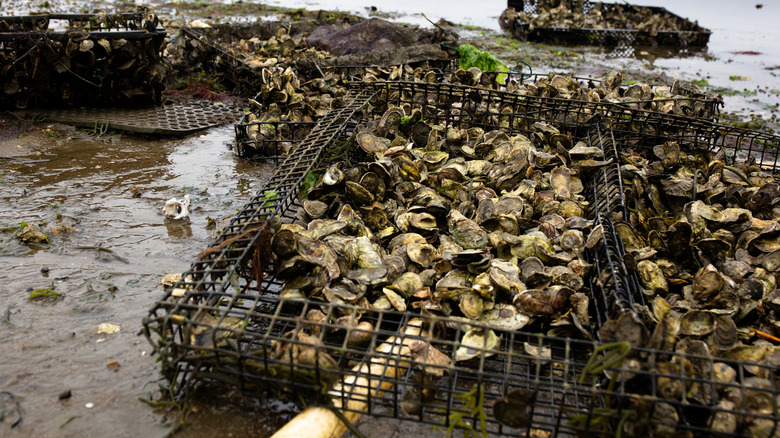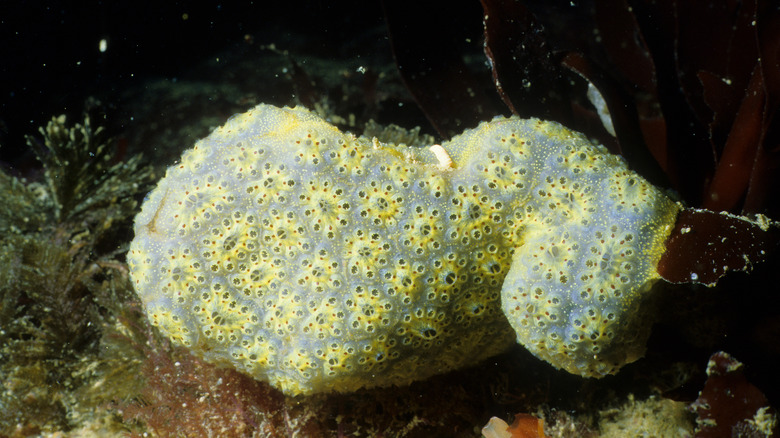Why US Oysters May Soon Be Harder To Come By
Even without the help of a microscope, the golden star tunicate can hardly be considered unattractive. Yet the species, also known as Botryllus schlosseri, is just one of a number of tunicates (which are invertebrate marine life that are grouped together) that have begun appearing along the eastern coastline of the United States and Canada. The origin of this particular creature is not clear. Oceanus states that while it was thought to be an invasive species, it is believed that these animals have always been around. Regardless of where it is from, the golden star feeds off tiny organic matter like bacteria and phytoplankton, according to Fisheries and Oceans Canada. When their numbers grow large enough, they threaten filter feeders that live in the same area, such as oysters, mussels, and scallops, because they feast on the same organisms.
Tunicates have already been found at oyster farms in Plymouth, Massachusetts, where owner Bill Doyle discovered another tunicate known as "sea vomit" because they managed to covered Doyle's oyster cages, cutting off fresh water and nutrition to the bivalves nestled within, in the process. Doyle told Oceanus, "Every piece of equipment — we had more than 3,000 pieces out — was completely covered." He added that cleaning up was a difficult task because its tough to determine where to even begin. Doyle says that he eventually lost money because it took months to clean off his equipment and also because thousands of oysters died as a result of the infestation.
Shellfish farmers have struggled to contain infestations
Science Direct states that there are over 3,000 different types of tunicates, or sea squirts. These creatures are survivors and are known to hitch rides by attaching themselves to oceangoing vessels, where they then find new areas to live and breed. Tunicates reproduce quickly and are not particularly sensitive to salinity. As a result, they are able to adapt and overpower new areas quickly, making them a threat to species that are native to an area. As ships and mollusk farms, which have had to fight off a tunicate invasion, can attest, getting rid of these sea squirts is not only time consuming, it's costly, too.
Oceanus reports shellfish farmers have been struggling to contain the growth of the invasive species since the 1980s, but the problem has worsened because of climate change. Doyle told the publication, "Tunicate invasions here have spiked in the last three or four years, and our water temperature has increased a lot during the same time period. And we now see some of the oysters starting to spawn which means consistent water temperatures above 70° F (21° C). We never had oysters spawn before. Water temperature is what I'm blaming it on." The invasive species has even been seen further north, where waters like in the Gulf of Maine have been at their warmest in recorded history.
Ocean-going vessels are asked to inspect their hulls for hitch-hiking tunicates
Shellfish farmer Alex de Koening, who had to clean up his oyster farm after a 2021 infestation, likens the invasive creatures to any invasive species that enters a new environment. He says, "You've got to deal with it early. It's like keeping up with the weeds in your little vegetable garden at home. You pull weeds a little bit here and there. But if you go on vacation for a month, suddenly you have an overgrown mess to deal with," per Oceanus.
As the first line of defense against this invasive species, ships are being asked to play their part to ensure the species doesn't make it out of their home waters. Sea Grant Oregon has a list of action items that include inspecting hulls before departure, removing any tunicates that are visible, and reporting them to coastal authorities if any managed to successfully hitched a ride back to the United States.


